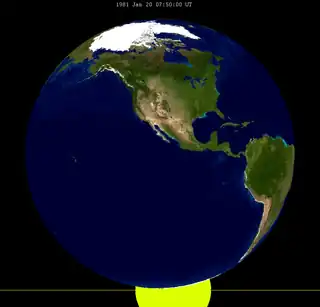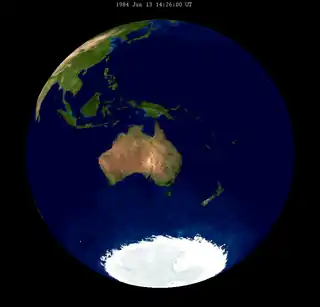July 1980 lunar eclipse
A penumbral lunar eclipse took place on Sunday, July 27, 1980, the second of three penumbral lunar eclipses in 1980. This very subtle penumbral eclipse was essentially invisible to the naked eye; though it lasted 2 hours, 17 minutes and 36.3 seconds, just 25.354% of the Moon's disc was in partial shadow (with no part of it in complete shadow). The moon passed in the northern edge of the Earth's penumbral shadow, and was the 70th lunar eclipse of Saros cycle 109.[1]
| Penumbral eclipse | |||||||||
| Date | 27 July 1980 | ||||||||
|---|---|---|---|---|---|---|---|---|---|
| Gamma | 1.41391 | ||||||||
| Magnitude | 0.25354 | ||||||||
| Saros cycle | 109 (71 of 73) | ||||||||
| Penumbral | 137 minutes, 36.3 seconds | ||||||||
| |||||||||
Visibility

Related lunar eclipses
Eclipses in 1980
- A total solar eclipse on Saturday, 16 February 1980.
- A penumbral lunar eclipse on Saturday, 1 March 1980.
- A penumbral lunar eclipse on Sunday, 27 July 1980.
- An annular solar eclipse on Sunday, 10 August 1980.
- A penumbral lunar eclipse on Tuesday, 26 August 1980.
Lunar year series
| Lunar eclipse series sets from 1980–1984 | ||||||||
|---|---|---|---|---|---|---|---|---|
| Descending node | Ascending node | |||||||
| Saros | Date Viewing |
Type Chart |
Gamma | Saros | Date Viewing |
Type Chart |
Gamma | |
| 109 | 1980 Jul 27 |
Penumbral |
1.41391 | 114 | 1981 Jan 20 |
Penumbral |
−1.01421 | |
| 119 | 1981 Jul 17 |
Partial |
0.70454 | 124 | 1982 Jan 09 |
Total |
−0.29158 | |
| 129 | 1982 Jul 06 |
Total |
−0.05792 | 134 | 1982 Dec 30 |
Total |
0.37579 | |
| 139 | 1983 Jun 25 |
Partial |
−0.81520 | 144 | 1983 Dec 20 |
Penumbral |
1.07468 | |
| 149 | 1984 Jun 13 |
Penumbral |
−1.52403 | |||||
| Last set | 1980 Aug 26 | Last set | 1980 Mar 13 | |||||
| Next set | 1984 May 15 | Next set | 1984 Nov 08 | |||||
Half-Saros cycle
A lunar eclipse will be preceded and followed by solar eclipses by 9 years and 5.5 days (a half saros).[2] This lunar eclipse is related to one partial solar eclipse of Solar Saros 116.
| July 22, 1971 |
|---|
 |
Saros series
This lunar eclipse is the third to last member of Saros series 109. The next event is on August 8, 1998. The previous event was on July 17, 1962.
Notes
- Hermit Eclipse: Saros cycle 109
- Mathematical Astronomy Morsels, Jean Meeus, p.110, Chapter 18, The half-saros